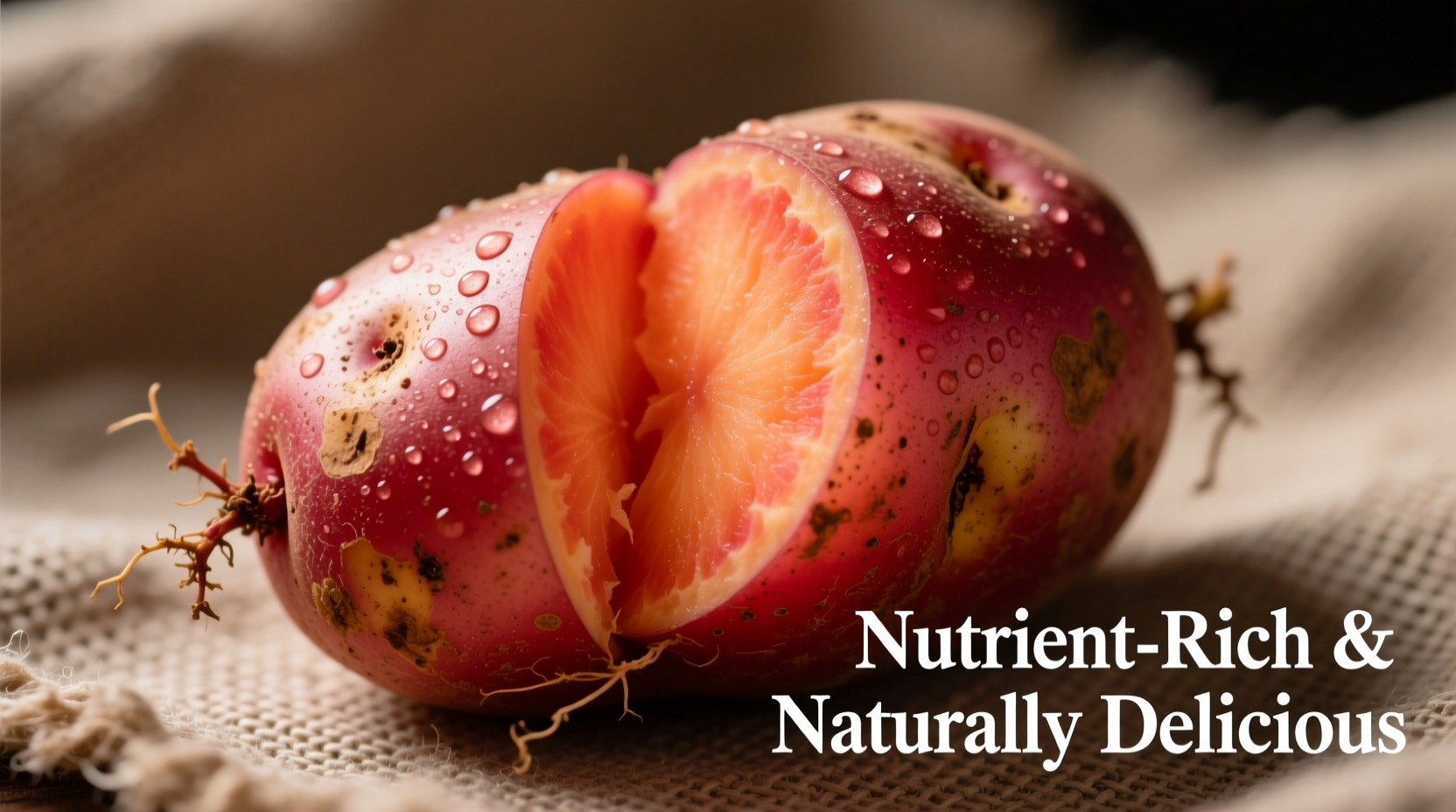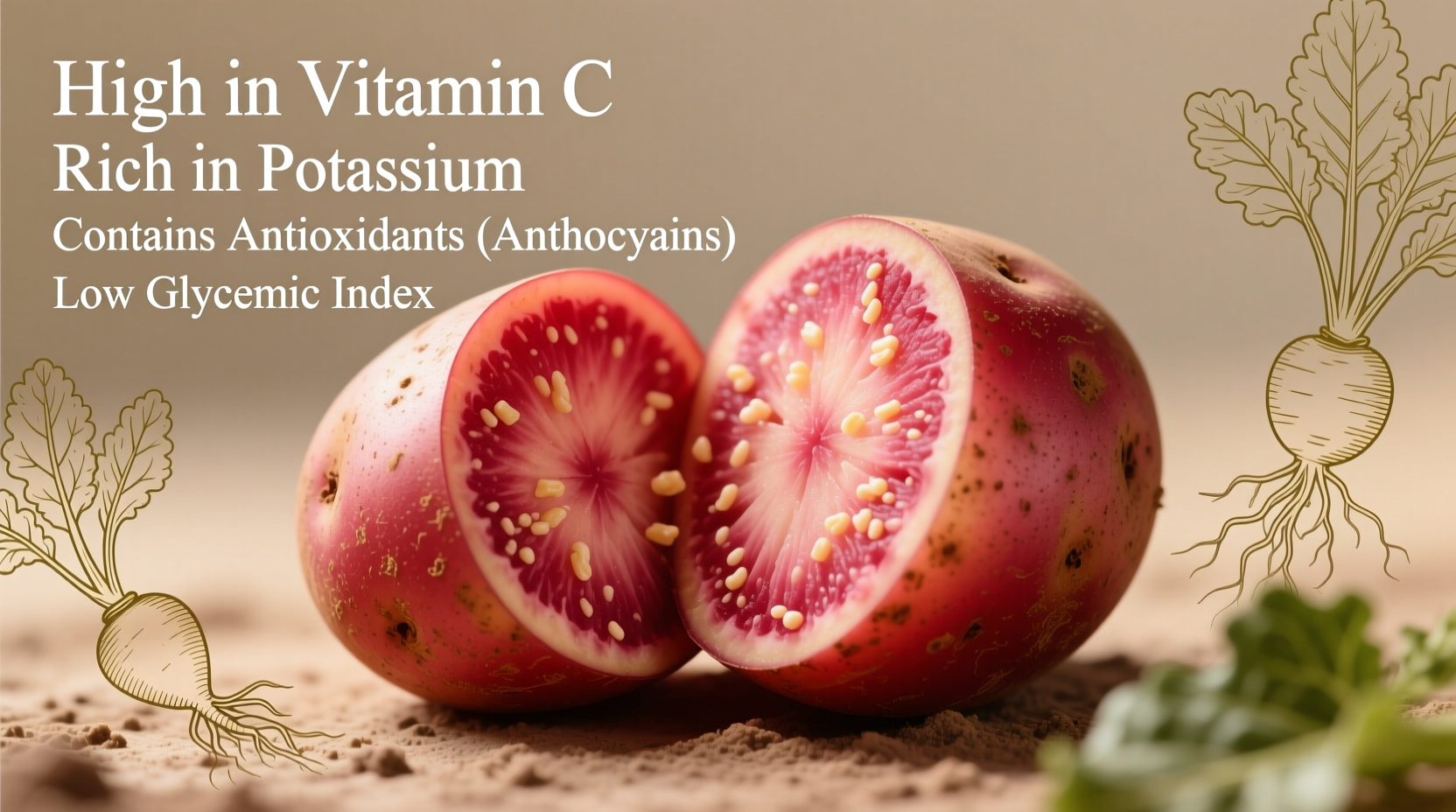Discover exactly what makes red potatoes a nutritional powerhouse in your diet. This comprehensive guide reveals science-backed facts about red potato nutrients that most cooking blogs overlook. You'll learn precisely how these vibrant tubers compare to other varieties, which cooking methods preserve maximum nutrition, and how to leverage their unique nutrient profile for specific health goals.
Red Potato Nutritional Profile: Beyond Basic Carbs
While often misunderstood as "just starch," red potatoes contain a remarkable array of nutrients concentrated primarily in their thin, edible skin. According to USDA FoodData Central, a medium red potato (150g) delivers:
| Nutrient | Amount per Medium Potato | % Daily Value |
|---|---|---|
| Calories | 150 | 8% |
| Carbohydrates | 34g | 12% |
| Fiber | 3g | 12% |
| Vitamin C | 17mg | 45% |
| Potassium | 926mg | 26% |
| Vitamin B6 | 0.5mg | 29% |
| Manganese | 0.2mg | 10% |
What makes red potatoes particularly valuable is their naturally occurring phytochemicals. The red skin contains anthocyanins—powerful antioxidants also found in blueberries—that provide anti-inflammatory benefits. Unlike processed foods, these nutrients come packaged with fiber that slows glucose absorption, making red potatoes a lower glycemic index option than many assume.

Health Benefits Backed by Research
Multiple studies confirm specific health advantages of including red potatoes in your diet. Research published in the Journal of Agricultural and Food Chemistry demonstrated that colored potatoes like red varieties contain up to 10 times more antioxidants than white potatoes. These compounds help combat oxidative stress, potentially reducing risk factors for chronic diseases.
For cardiovascular health, the potassium content in red potatoes plays a crucial role. The National Institutes of Health notes that adequate potassium intake helps maintain healthy blood pressure levels. A single medium red potato provides more potassium than a medium banana, making it an excellent choice for heart-healthy eating patterns.
Red Potatoes vs. Other Varieties: Nutritional Differences
Understanding how red potatoes compare to other varieties helps you make informed dietary choices. While all potatoes share similar basic nutritional profiles, key differences exist:
- Red vs. White Potatoes: Red potatoes contain significantly more antioxidants due to their skin pigmentation. White potatoes have slightly higher glycemic index values.
- Red vs. Sweet Potatoes: Sweet potatoes lead in vitamin A content, but red potatoes provide more potassium and vitamin C per serving.
- Red vs. Russet: Russets have more fiber but red potatoes offer superior antioxidant profiles.
According to agricultural research from the International Potato Center, the nutritional composition of potatoes has evolved through selective breeding. Modern red potato varieties contain 15-20% more antioxidants than those grown 30 years ago, reflecting intentional breeding for enhanced nutritional value while maintaining desirable culinary properties.
Maximizing Nutritional Benefits: Practical Tips
How you prepare red potatoes dramatically affects their nutritional value. To preserve maximum nutrients:
- Keep the skin on: Up to 50% of the fiber and many antioxidants reside in or just beneath the skin.
- Choose gentle cooking methods: Steaming or microwaving preserves more water-soluble vitamins than boiling.
- Cool before eating: Allowing cooked potatoes to cool increases resistant starch content by up to 50%, improving gut health benefits.
- Pair with healthy fats: Combining with olive oil or avocado enhances absorption of fat-soluble nutrients.
For individuals managing blood sugar, research from the American Journal of Clinical Nutrition shows that consuming red potatoes as part of a balanced meal with protein and healthy fats results in a more moderate blood glucose response than expected. The natural fiber and resistant starch content helps moderate the glycemic impact.
When Red Potatoes Shine: Contextual Benefits
Red potatoes offer particular advantages in specific dietary contexts. Athletes benefit from their ideal carbohydrate-to-potassium ratio for optimal muscle function and recovery. For individuals following plant-based diets, red potatoes provide bioavailable iron when paired with vitamin C-rich foods. During pregnancy, the folate and potassium content supports healthy development, though portion control remains important.
However, certain medical conditions require consideration. People with kidney disease may need to monitor potassium intake, while those with nightshade sensitivities might experience inflammation. Always consult with a healthcare provider about dietary adjustments for specific health conditions.
Frequently Asked Questions
Are red potatoes healthy for weight loss?
Yes, when prepared properly. Red potatoes provide high satiety due to their fiber and resistant starch content. A medium red potato contains only 150 calories and keeps you feeling full longer than many processed carbohydrate sources. The key is preparation method—baking or steaming with skin intact preserves nutrients while avoiding added fats.
Do red potatoes have more nutrients than white potatoes?
Red potatoes contain significantly more antioxidants, particularly in their skin, due to anthocyanin pigments. Both varieties have similar vitamin and mineral profiles, but red potatoes generally have slightly lower glycemic index values. The nutritional difference isn't dramatic, but the antioxidant advantage makes red potatoes a slightly more nutrient-dense choice.
Should I eat red potato skin for maximum nutrition?
Absolutely. The skin contains up to 50% of the fiber and significant concentrations of antioxidants and nutrients. When properly washed, the thin skin of red potatoes is completely edible and nutritionally valuable. Organic red potatoes minimize concerns about pesticide residues while maximizing nutritional benefits.
How do cooking methods affect red potato nutrients?
Boiling causes the most nutrient loss, particularly water-soluble vitamins like vitamin C. Steaming, baking, or microwaving preserves more nutrients. Cooling cooked potatoes increases resistant starch content by up to 50%, enhancing gut health benefits. For maximum nutrition, cook red potatoes with skin intact using minimal water and allow to cool before eating.











 浙公网安备
33010002000092号
浙公网安备
33010002000092号 浙B2-20120091-4
浙B2-20120091-4